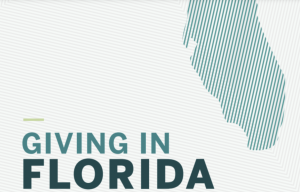Floridians Giving Locally, Not Nationally

Almost 70% of households in Florida (69%) report making charitable donations during 2021, with an average household donation of $1,035, and a majority of their giving focused on nonprofits within the state, according to a new survey of donors in the Sunshine State.

Giving in Florida provides an in-depth examination of the charitable giving patterns, priorities, and attitudes of Florida households and provides insight into giving patterns in 2021. The Florida Nonprofit Alliance and the Jessie Ball duPont Fund initiated the project, which was researched, analyzed, and written by the Indiana University Lilly Family School of Philanthropy. The survey was fielded by the Public Opinion Research Lab at the University of North Florida.
“As nonprofits are starting to recover from the financial impact of COVID-19, this study offers a tremendous amount of information about our state’s donors that can help make our state and local nonprofit sector even stronger,” said Sabeen Perwaiz, president and CEO of Florida Nonprofit Alliance, via a statement.
The goal of the project was to develop a benchmark of Florida’s philanthropic climate, learn about factors that affect individual giving in the state and help educate donors, nonprofit leaders, and board members about how best to reach their constituents.
In addition to examining more structured forms of philanthropy, the study finds that 87% of Florida households report making informal donations, such as giving to crowdfunding campaigns, donating goods to a food bank, or helping friends or family in need. More than half of all respondents reported giving directly to people in need within Florida.
The survey provides in-depth analysis of giving differences by different types of households and demographics. Nine out of 10 high-net-worth (HNW) households gave to charity, and they did so in significantly larger amounts than general population households. HNW households also were significantly more likely to donate a larger share of their giving to U.S. organizations not based in Florida, as compared with general households.
Donors ages 65 and older were more likely to give to registered 501(c)(3) charities and more likely to give a larger share of their charitable dollars to Florida-based organizations, as compared to respondents age 40 and younger who are more likely to volunteer and more likely to be informal givers compared to formal donors.
Access to MinistryWatch content is free. However, we hope you will support our work with your prayers and financial gifts. To make a donation, click here.
“The Giving in Florida study captures generosity from people from all backgrounds who give to formal nonprofits but also give money directly to others, donate goods, or volunteer,” said Una Osili, Ph.D., associate dean for research and international programs at the Indiana University Lilly Family School of Philanthropy. “These individuals tend to be younger, more diverse, less religious and have significantly lower incomes than formal donors. This type of generosity has been practiced for centuries, but it has traditionally not been researched. Having this data allows us to gain a better and more complete understanding of Florida’s philanthropic landscape,” she said.
“This research provides a more nuanced view of Floridians’ generosity, and will support our nonprofits in empowering the next generation of givers in our state,” said Mari Kuraishi, president of the Jessie Ball duPont Fund.
The study also reveals regional differences in giving patterns. Southeast Florida, the region that includes Miami and Fort Lauderdale, among other cities, represents the largest share of total charitable giving. The share of charitable dollars going to local charities, however, was distributed more evenly around the state, with Southeast, Northeast, and Central Florida representing similar shares of total giving to local charities.
Specifically, Giving in Florida finds that more than a quarter of Floridians reported giving to racial reconciliation causes in 2021. Direct support for individuals was the most popular form of racial justice giving, with 12.8% of respondents giving in this way, followed by giving to established organizations (11.5%) and giving to grassroots organizations (11.4%).
Among other findings of the research:
- 69% of households report giving to charity in 2021
- Households in the typical population donated an average of $1,035 during 2021 and HNW households donated an average of $15,294;
- The top three issue priorities were poverty and income inequality; health, and climate change and the environment.
- The top three areas in terms of largest average donation amount in 2021 were religion, basic needs, and health.
- The top reason for giving to charity was feeling compassion toward people in need, followed by donating because friends gave to charity.
- The top reason for stopping giving to an organization previously given to was mismanaging donations, followed by donors changing their giving to charities working on different issues.
- More than three quarters of respondents 65 and older had a will but of those, only 15.5% had a charitable bequest. Donors most likely to stipulate a charitable bequest to a Florida-based organization were younger and more diverse than the average respondent with a will.
The study surveyed 1,444 households in January, with an oversample of households considered to be high net worth, defined as having an annual income of $200,000 or more and/or net assets of $1 million, excluding their primary residents. The total sample was weighted by age, sex, race, education, geographic location, and annual household income, using the 2019 American Community Survey update.
This article was originally published by The NonProfit Times. It is reprinted with permission.



